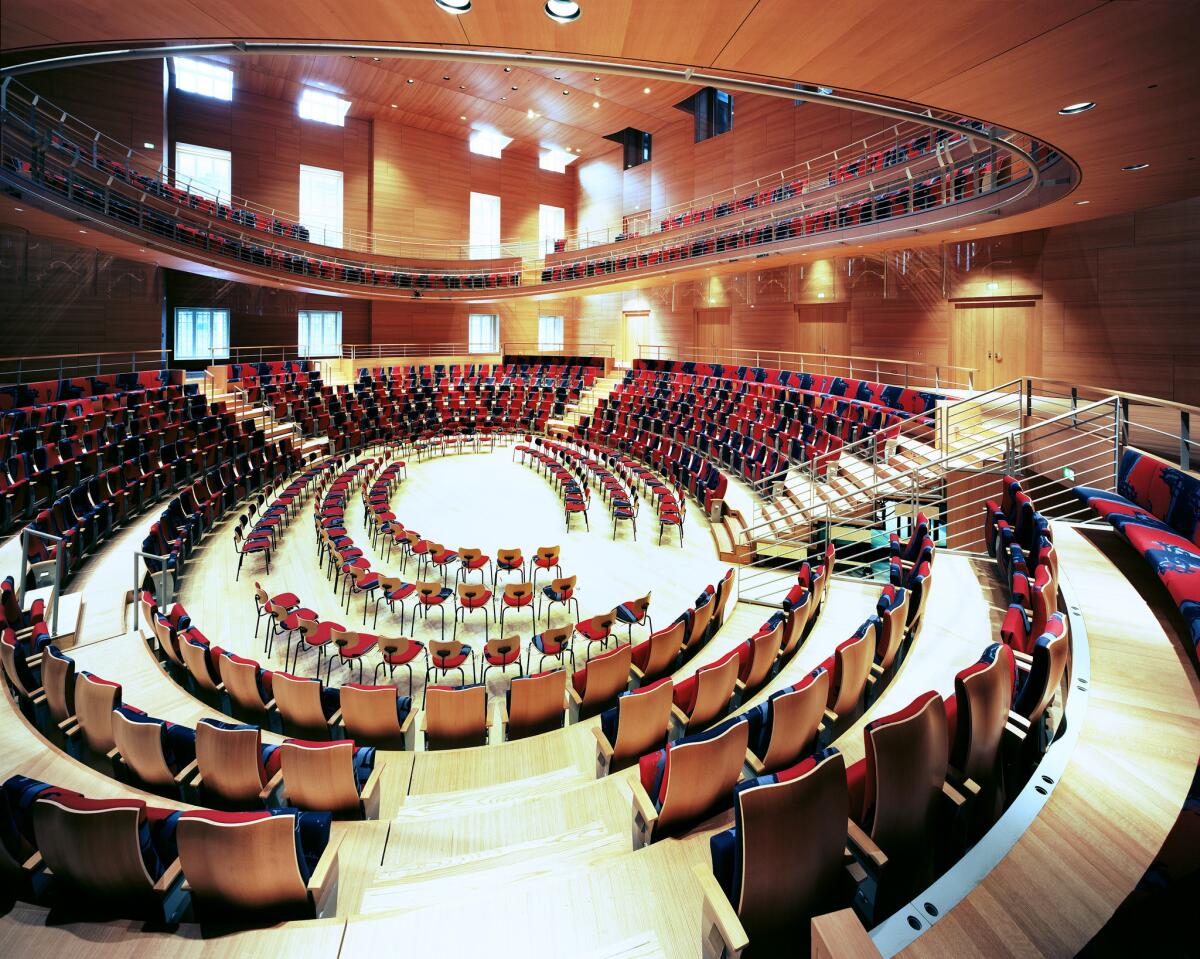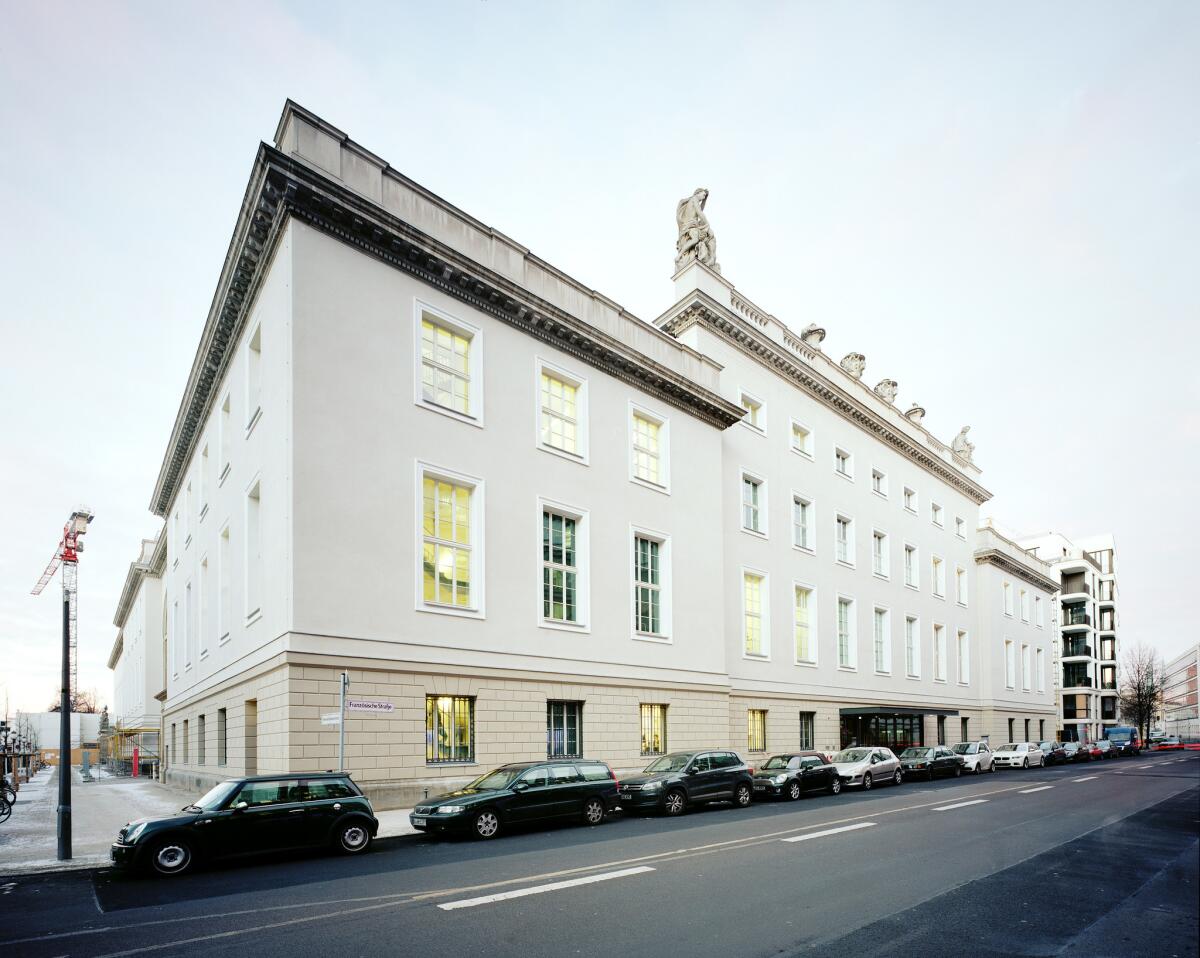Review: Frank Gehry’s new jewel-box concert hall in the heart of Berlin
Gehry took the idea to heart, designing a series of houses that were miniature villages in which each room became, in essence, its own structure. But he’s never had a chance to explore the potential of single-room architecture quite as directly as in Pierre Boulez Hall in Berlin, which he designed in collaboration with pianist and conductor Daniel Barenboim.
The project has been one of near-obsessive interest over the last four years for the classical music-loving Gehry, and that is one reason the architecture and music critics who follow his work have been so eager to see it. (He waived his usual fee.) But the final product never quite strikes the unusual balance of refined and unrefined spaces, of humanism and careful proportion set against the ad hoc and the thrown together, that marks his most effective designs.
The hall opened Saturday night with a concert of chamber music and art song by Boulez, Schubert, Mozart, Alban Berg and Jörg Widmann that stretched more than three hours and drew a rousing response from an audience including German President Joachim Gauck, architect Rafael Viñoly, curator Stephanie Barron and
The 682-seat hall is tucked into one corner of a four-story building from 1955 that was designed by architect Richard Paulick to store sets for the Berlin State Opera, where Barenboim is music director. The building, which sits rather anonymously on a corner in the Mitte district, in the heart of Berlin, backing up to an important civic plaza called Bebelplatz, is now the headquarters for the Barenboim-Said Academy, a conservatory that includes young Israeli and Arab musicians.
The academy has its roots in the West-Eastern Divan Orchestra, which Barenboim founded in 1999 with the late Palestinian American writer and Columbia University professor Edward Said.
The building is split almost perfectly down the center by a tall, narrow atrium. On one side are offices and rehearsal spaces for the academy. On the other is Boulez Hall, named for the French composer and conductor who was close to both Barenboim and Gehry and who died last year at age 90.
The name of the auditorium in German, Pierre Boulez Saal, reflects its architectural personality. The word “Saal” means both hall and room. And, of course, much of the chamber music that will be performed there was written for living rooms and other small spaces.

Because the redesign of the rest of the 1955 building (including the administrative space for the academy) was handled by a German office, HG Merz, Gehry could focus all his attention on the performance space, which covers just 10,660 square feet. His collaborators on the project at his firm, Gehry Partners, included Craig Webb, Laurence Tighe, Meaghan Lloyd and Gesa Buettner. The total budget for auditorium and academy was $36 million.
Working with acoustician Yasuhisa Toyota, who also handled the remarkably good sound design for Gehry’s 2003 Walt Disney Concert Hall in Los Angeles, the architect produced a clubby jewel box of a design that is also a sophisticated machine for delivering sound.
The walls and ceiling are wrapped, more seamlessly than at Disney, in panels of Douglas fir, though you can see right through the windows of the old building to the street. Before performances, shades slide down to block out the light. They reopen during intermissions, which is a nice touch.
The most striking and unusual feature of the hall is its sunken stage, which isn’t really a stage at all as much as a clearing, nine feet below entry level and surrounded by an oval-shaped arrangement of five rows of seats. A balcony with two rows — largely detached from the structure of the larger room, so that sound can travel up under and around it — forms another oval above.
It’s a remarkably intimate space for music. Every seat is within 50 feet of the stage.
The design is much closer to a theater in the round than a traditional concert hall; even at Disney Hall, which also puts the audience in a ring around the performers, there are some seats that dip below the stage.
Here, the first row of seats is directly level with the musicians and their instruments. Audience members in those seats put their feet on the same surface the performers do, just like
Another unusual feature is the ease with which the musicians can be repositioned as a concert unfolds. When he wasn’t at the piano, Barenboim conducted from two different edges of the stage over the course of the Saturday performance as well as from the balcony.
That sense of openness and flexibility — an interest in rejecting the monumental or doctrinaire — connects the hall’s architecture with that of the Berlin Philharmonie, a brilliant 1963 design by Hans Scharoun that heavily influenced Disney Hall. As an interior project, the hall is linked to Gehry’s only other design in Berlin, the 2000 Deutsche Bank offices near the Brandenburg Gate.
There are also hints here of Alvar Aalto and — especially right when you walk in and see the sunken stage area lighted from above as if by some giant hidden skylight — of Karl Friedrich Schinkel’s 1816 Neue Wache, a crypt-like building two blocks from Boulez Hall that has a round, Pantheon-like opening in its ceiling.
The glass acoustical sails that are suspended beneath the balcony — though delicately detailed enough to avoid standing out — are among a handful of signs in the final design that Gehry’s interest in making nearly every major architectural form acoustical and vice versa, which is one of Disney Hall’s great strengths, wound up just out of reach in Berlin.
On the whole, the Gehry on display here is a tamed, or at least tempered, version of the one who so memorably combined that wood-lined interior in Disney Hall with floral upholstery whose busy pattern seemed marshaled to tweak the aesthetic sensibilities of L.A. Phil subscribers.
That effort was even more pronounced in Gehry’s very good 2011 building for the New World Symphony in Miami, which has lobby banquettes covered in aqua-blue Naugahyde. Boulez Hall has seats in a more muted blue and red pattern.

In other ways — more important ways — that sense of the irreconcilable lies at the heart of Boulez Hall both architecturally and culturally. The outer walls of the hall make up a box that’s nearly a cube. The gestures that Gehry makes inside that box are anything but predictably rational. In fact, they seem distrustful of the way that architectural symmetry can make an easy or saccharine argument for harmony.
Instead, he makes the stage an oval and then suspends another, larger oval above to hold the balcony. The balcony itself is an undulating form, dipping toward the stage on two sides.
So in plan (as seen from above) and in section (as seen looking across or through the building), the design for the hall is a collection of stretched, ill-matched or distorted ovals, suggesting the difficulty of achieving some architectural version of musical harmony.
One of Gehry’s early sketches for the design, from 2012, is reproduced in a display in the lobby and appeared on the cover of the program booklet Saturday night; in that version, the overlapping ovals suggest a hurricane, with the stage in the center representing the eye of the storm.
The hall as built is missing some of that sense of turbulence; that troubled early geometry has been smoothed out, which is a disappointment. Gehry, after all, has often mined to great effect the vein where beauty (or proportion) and harshness come together or where beauty can no longer sustain itself. Or where it’s simply an inappropriate response.
Still, the symbolism of those clashing ovals closely matches the spirit both of Boulez’s music and Barenboim’s vision for the academy and the West-Eastern Divan Orchestra.
Barenboim has stressed over the years that his goal in bringing together Arab and Israeli musicians is not to make peace or even suggest that it’s within reach; he is not as naive as that. Instead, he wants to create a platform for connection and engagement, one necessarily shadowed by anxiety about political reality.
“It’s an experiment,” Barenboim acknowledges in an interview published in the program. “But … we have to put all cards on the table and say, ‘This is what this hall is about.’ ”
christopher.hawthorne@latimes.com
Twitter: @HawthorneLAT
ALSO
Pritzker goes to Catalan trio, with a nod to the forces behind Brexit and Trump
L.A. in the 1970s: A visual and architectural treasure trove at LAXART
How the best picture fiasco saved the Oscars from nostalgia overload
The biggest entertainment stories
Get our big stories about Hollywood, film, television, music, arts, culture and more right in your inbox as soon as they publish.
You may occasionally receive promotional content from the Los Angeles Times.








